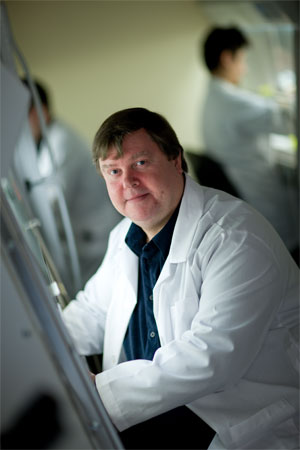 |
| Dr. Chris Richardson is the Canada Research Chair in Viral Vaccinology and Therapeutics. |
There may be a silver lining in the dark cloud that is the swine flu pandemic.
“H1N1 creates nasty disease symptoms – including aches, fever, nausea, and coughing – but it is also a learning experience,” says Christopher Richardson, the Canada Research Chair in Viral Vaccinology and Therapeutics.
Delays in vaccine delivery and queues at clinics create the impression that the public health response to this challenge is slow. But compared to reaction times in the past, preventive vaccines are available sooner than ever before.
“I lived through the SARS epidemic in Toronto, it was right next door to me at the hospital and people I know ended up catching it and suffering respiratory distress,” he recalls. “In that case, the public health response took too long. We would like to know how to make vaccines fast.”
The process is that the World Health Organization (WHO), in collaboration with laboratories around the world such as the Centre for Disease Control (CDC) in Atlanta, identifies pandemic risks and supplies strains to drug companies.
“In this case, companies were making an H1N1 vaccine within 12 to 18 weeks from the moment the pathogen was first identified – it’s now a faster, more efficient process,” says Dr. Richardson.
The H1N1 inoculation is based on existing vaccine technology and is a slightly modified version of the familiar flu shot.
While Dr. Richardson was involved in studies of the influenza virus earlier in his career, his current focus is on measles, along with hepatitis B and C.
As a researcher with the Canadian Center for Vaccinology, he is exploring cutting-edge applications of vaccine technology. They’re growing colonies of virus infected cells, extracting RNA and cloning it. Then through reverse genetic engineering, the RNA is turned into DNA. This DNA is introduced into the measles virus, to create a multi-valent vaccine – one that is effective against more than one disease and is particularly long lasting. More futuristic ideas include developing novel ways to combat HIV and cancer.
“Influenza vaccines were invented in 1944 after it became possible to culture influenza virus in eggs. It’s a relatively old technology that is still used by many pharmaceutical companies. With methods developed over the last decade, efficient and faster manufacture of new generation influenza vaccines will become more accepted over time – and with that, it will make pandemics less of a threat,” says Dr. Richardson.
